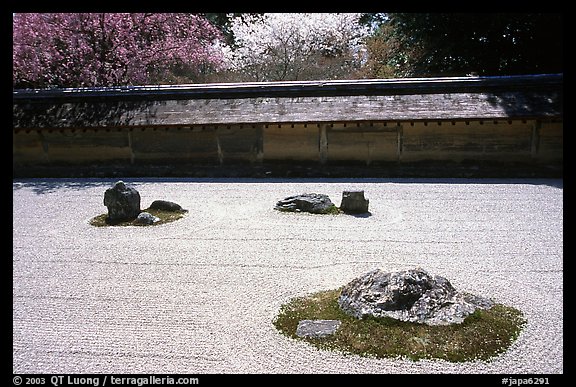I have been very attracted to the idea of a Zen garden. A space to sit quietly, meditate, draw, read. A space that you know even if others enter the garden, your personal peace will not be disturbed.
I just found this article which I found interesting in its own simplicity and I decided I wanted to add it to my blog so I have a reminder of the things I would like to achieve. I'm hoping I may be able to create a zen garden in Earthsong (I have edited this a little in places - actual article can be found by clicking on the title link). One of the other features I would like to incorporate into my garden would be a space for all the elements - earth, air, fire, water and spirit.
--------------------------------------------------------------------------------
A Zen garden is the perfect spot to sit and contemplate. Originally a Japanese style of garden, it combines both natural and architectural elements.
 The Zen spiritual garden was used by Japanese Buddhist monks from around the 13th century as a place to contemplate and meditate. Layered to create a three dimensional image, a Zen spiritual garden is planned with a foreground and a background leading into a perspective.
The Zen spiritual garden was used by Japanese Buddhist monks from around the 13th century as a place to contemplate and meditate. Layered to create a three dimensional image, a Zen spiritual garden is planned with a foreground and a background leading into a perspective.
 Water features
Water features
All elements have a purpose for being in the garden and water is the provider of life. It is a natural element that can be displayed as a stream, pond or water feature.
 Sand can also be used to represent water, an ideal solution in dry climates, but using the real thing is ok too.
Sand can also be used to represent water, an ideal solution in dry climates, but using the real thing is ok too.
 Plants
Plants
Plants bring emotion to the garden with various colours, heights and textures.
 Rocks for your garden
Rocks for your garden
Rocks are one of the most important elements of a Zen garden because they create dimension. They reflect the scale of time and also provide presence and energy. Select your rocks and stones and then grade them into sizes, with larger to the front and smaller in the background. Choose well worn rocks to add depth and character.
 Water alternatives
Water alternatives
A sand or pebble formation can be used as an alternative to the element of water. Swirl the sand around to create a rippling or rushing water effect and the swirls will also provide energy to the garden. The sand used in Zen gardens is not beach sand but crushed granite and comes in various shades. Use light coloured pebbles to brighten up a dark area.
 Bridge your garden
Bridge your garden
A bridge is one of the architectural elements that can be used in a Zen garden. They are used to connect different areas of the garden and provide you with views of the garden otherwise unobtainable.
 Decorative ornaments
Decorative ornaments
Ornaments are another architectural element that add atmosphere to the garden and serve as focal points. They are ideal for helping to create a sense of distance. This stone lantern (pictured) is in keeping with the Zen feel of the garden.
 Gated garden
Gated garden
The beauty of a Zen garden is it can be created in the smallest of spaces. The illusion of depth and space can be created through the placement of elements. Place a gate at the entrance of your garden to further enhance the illusion.
 The Zen spiritual garden was used by Japanese Buddhist monks from around the 13th century as a place to contemplate and meditate. Layered to create a three dimensional image, a Zen spiritual garden is planned with a foreground and a background leading into a perspective.
The Zen spiritual garden was used by Japanese Buddhist monks from around the 13th century as a place to contemplate and meditate. Layered to create a three dimensional image, a Zen spiritual garden is planned with a foreground and a background leading into a perspective. Water features
Water features Sand can also be used to represent water, an ideal solution in dry climates, but using the real thing is ok too.
Sand can also be used to represent water, an ideal solution in dry climates, but using the real thing is ok too.  Plants
Plants Rocks for your garden
Rocks for your garden Water alternatives
Water alternatives Bridge your garden
Bridge your garden Decorative ornaments
Decorative ornaments Gated garden
Gated garden